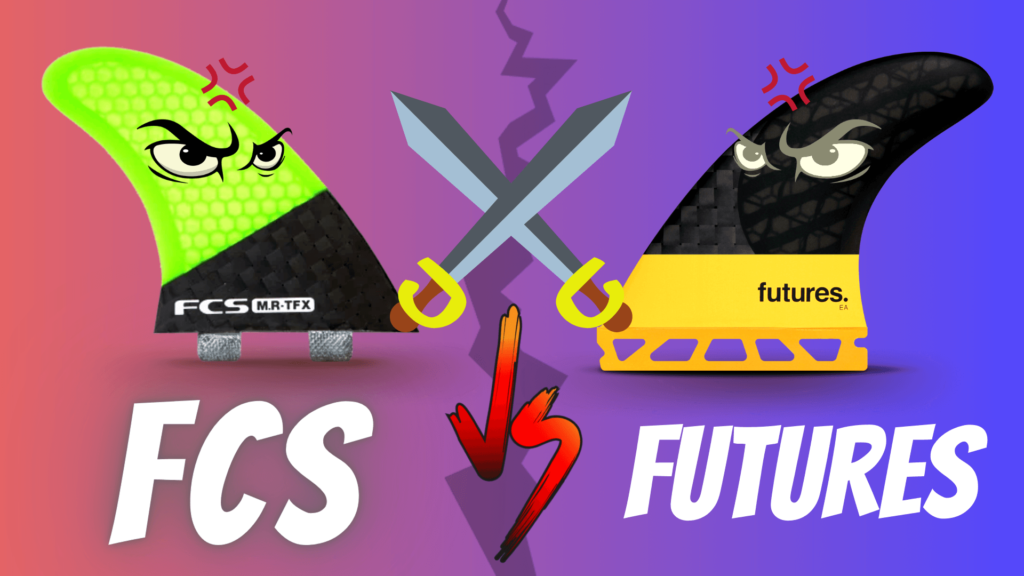
The Battle of the Fins: FCS vs Futures?
You are thinking about buying a surfboard and you don’t know which fin system to choose? Futures or FCS plugs? What difference exists between one system and another? Which one is better? What advantages do Futures fins have versus FCS fins ? We leave you a video summarizing the pros and cons of each system:
Next, we try to answer the great dilemma affecting many surfers when it comes to choosing the fin attachment system for their surfboard.
FCS Fin System
Undoubtedly the most widespread worldwide. In our country, practically 80% of the boards sold have this system. FCS Spain has done a good job.
Originally designed in the early 90s, FCS or Fin Control System was the pioneering system in removable fin systems. Its creation was a true revolution in the surf industry as it allowed surfers to easily change the set of fins to adjust to the sea conditions. The FCS Fins system was designed by Brian A. Whitty in Australia.
View FCS fins catalog
✓ FCS Features
- It has two tabs on the bottom. Fins attach to the board with 2 screws.
- Used by many professional surfers. They had Kelly Slater as an ambassador for many years.
- They are removable fins. FCS offers a wide range of fin models and up to three attachment systems.
- The new FCSII does not require a securing screw. However, even Slater himself uses screws to ensure the fins are securely attached to the board. The main drawback of FCS2 is the risk of losing them. Just ask Gabriel Medina. Another aspect to consider if your board comes with FCS 2 fins is that you have to be careful when putting them on and taking them off. We recommend placing your board on a soft surface. Since both putting on and removing the FCSII fins requires strong pressure.
- An advantage of FCS fins is that at a pressure of approximately 75 kg-80 kg they break and therefore, it is less likely to damage the fin box.

➕ Buy your FCS fins at Single Quiver. Complete catalog.
➕ FCS Surf fins buying guide : How to choose the right model for my level and type of surfing.
Futures Fin System
Very popular in the USA. It is the second most used fin attachment system in our country. Among its ambassadors are Jordy Smith, Clay Marzo, and John John Florence.
Futures Fins are a benchmark in surf fins worldwide . The Californian brand is a leader in sales of high-performance surfboard fins. It started its journey in a garage in Huntington Beach in 1996. The Longo brothers, creators of the Futures fins brand, were known for taking on all challenges in creating aerospace parts. In 1996, they decided to combine their technical knowledge from the aerospace world with another of their passions. Surfing. As a result of this relationship, the first set of Futures fins was born. A surf fin, designed from .
Currently, Futures Fins has a team of internationally top-level surfers. John John Florence, Rob Machado, Jordy Smith, Clay Marzo, and Dave Rastovich are just some of the surfers who put a face and name to these fins. Futures also offers a wide variety of fins. Single fins, twin fins, 2+1 fins, thruster, quad, five fins.

What is the best fin system for your surfboard?
Like everything in this life. A matter of taste. The reality is that Futures and FCS have been fighting for market share for years. These two brands are going crazy to attract followers. But is there a true winner?
✌️ FCS Fin Advantages
FCS has dominated fin setup options for a decade, but has never come to have a monopoly.
The brand has developed a wide range of materials to improve driving, grip, and turning on the face of the wave. Its fins are made with the latest materials: ultralight epoxy, composite core, performance core, performance glass, and glass flex. Their commitment to innovation and technology has made them a sales leader for many years. But… then Futures Fins arrived.
The best of FCS surf: ‘80% of the boards manufactured in our country have FCS plugs.’
Undoubtedly its main advantage versus Futures is the good work done to date. FCS was almost the only option at the beginning of the century. The fact that 80% of the surfboards sold in our country come with FCS plugs implies that each surfer has at least a couple of sets of FCS fins per board.
The worst of FCS
Surfers often complain that FCS plugs are worse than Futures and that they usually damage the deck of the boards. The new Fusion plugs were introduced precisely to avoid board carnage.
Another widespread complaint is that FCS fins do not provide the same feel as Futures. The fact of having two holds, versus the total grip of Futures, is noticeable.

FCS 2 System
✌️ Futures Advantages
Surf fin enthusiasts feel that Futures fins are stronger and more resistant . And when they break, they usually break at the base. So all you have to do is replace the fin, instead of having to repair the surfboard.
Those who use Futures speak of a more direct response from the board and that it is more resistant because the fin is better secured, something that FCS has tried to correct with its new system, the FCS II. Futures plugs are considered ‘user-friendly’, or in other words, easy to use. They can be easily removed and replaced.
The worst of Futures
Today, it is still easier to find shapers who work with FCS than with Futures. In fact, not all surfboard brands give you the option to install Futures. We could practically say that the FCS system is the standard in the world. While it is true that in recent years things are changing.
The vast majority of surfers have up to 5 sets of FCS fins. Taking the leap and switching to Futures implies a significant expense. We already know that surf fins, are not exactly a cheap item. Fin prices range from 27 euros for plastic fins to 130 euros for a set of six or five fins. Repair workshops are more accustomed to making repairs on boards with FCS plugs.
Alternative to switching from FCS 1 to Futures
There is also an alternative to switching from FCS 1 to Futures, and that is these adapters that make FCS 1 fins compatible with Futures plugs.
These adapters, costing no more than $79, are from the American brand Wasabi. Assuming the board has Future plugs, you can use the full range of FCS 1 and Future fins. It is a very good way to make the most of all those fin sets, which you couldn’t use if you switch to the other fin attachment system.

Now we just need them to do it for the FCS 2 system.
Cheap FCS fins
The cheapest FCS fins cost 45 euros. These are the
trifin performer glass flex model . Designed for all types of surfboards with trifin configuration. Ideal for surfers who want a reliable ‘All Round’ fin that provides a combination of speed and maneuverability with flow between turns. FCS fins for only 45 euros

Another option for cheap and quality FCS 2 fins are the FCS 2 Performer Neo Glass Trifin Fins. These fins are designed to maximize speed, flow, and response.

FCS 2 PERFORMER NEO GLASS TRIFIN
Cheap Futures fins
The cheapest Futures fins cost 40 euros and can be found in our surf fin outlet .

FUTURES FINS F8 SAFETY
Otra opción de quillas Futures Fins barata y de calidad, It is the Alpha range of Futures. Created in collaboration with pro surfer John John Florence, it is the best option for those surfers looking for high performance on their board.

John John Florence Fins
Our Opinion, FCS 2 or Futures Fins?
Let it be clear that in SURF FINS MAGAZINE we do not have preferences for one brand or another. Moreover, we are sure that the average surfer will not notice the difference between the two fin systems. Perhaps if we had to lean towards a system, not towards a brand, our winner would be Futures especially when it comes to Twinfins.
The battle is on. Who will win? FCS Europe or Futures? We will have to pay attention to the next evolution in terms of fins.
At SURF FINS MAGAZINE we are aware that surf fins have become a luxury item. A set of carbon fins costs an average of 80 euros. That is why we have created a section for Fins Outlet where you can find the best fin deals online. Buy your set of Futures fins from 41 euros. If you have doubts about which fins to buy, visit our fin recommender .
